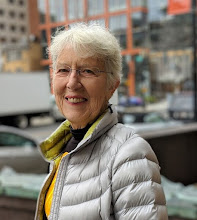On X (Twitter) today I found the following quote posted by poet Ilya Kaminsky -- quoting recently deceased poet Fanny Howe (1940-2025). Howe's poetic statement, quoted below, is one that applies (for me, at least) to both poetry and mathematics:
One way to understand your own condition is to write something and spend a long time revising it.
In revising you teach yourself. You find your own information buried in your body. It is still alive until you are not.
Here, at PoetryFoundation.com, are more than twenty of Howe's poems; I offer one of these below:














